Mutley's Hangar
A Haven For Flight Simulation Enthusiasts!
.jpg)
For FSX/Prepar3D Published by Carenado
Reviewed by Andrew Godden
November 2014
Introduction
Pilatus Aircraft have been producing STOL utility and trainer
aircraft since 1939. With a reputation for designing and producing
quality aircraft, Pilatus have had success with a range of models
since the late 1950s, all of which are still in current production.
The PC-6 'Porter' and PC-7 trainer cemented Pilatus' reputation
early, with later success following with the PC-9 and PC-21
trainers. The Pilatus PC-12 was designed for corporate transport and
regional airline operators and has become Pilatus Aircraft's most
successful aircraft.
Carenado already have in their offering, three aircraft of a
comparable role and configuration to the PC-12, they being the
Cessna 208B, Piper PA-46T 'Malibu' JetPROP, and Socata TBM 850. It
seems fitting then, to add the PC-12 to this "increasingly
inaccurately named.....trilogy" of single engine turboprops. With
exemplary cruise speed, range / payload characteristics, and STOL
capabilities, the PC-12 is a brilliant aircraft.
History
The Pilatus PC-12 is a single engine turboprop passenger and cargo
aircraft. Powered by a Pratt and Whitney Canada PT6A turboprop
engine, the PC-12 is certified for single pilot IFR operations. With
seating capacity for up to nine passengers in a standard
configuration, four passengers in a passenger / freight combi
configuration, and six passengers in a corporate transport
configuration (seven passengers with an option bench seat in the
rear row), the PC-12 is a very versatile aircraft for regional
airline and / or corporate transport operators.
Development of the PC-12 began in 1989, with the first flight taking
place on 31 May 1991. After a redesign of the wings, resulting in an
increase in the wing span and the addition of winglets to meet
performance guarantees, production deliveries commenced in 1994. The
Royal Flying Doctor Service (RFDS) in Australia was the launch
customer for the PC-12 and they continue to be the single largest
operator of the type. With over 1300 aircraft produced to date, and
plans for future upgrades and variants, the PC-12 will continue to
be the mainstay of Pilatus production for years to come.
Availability and Installation
The Carenado Pilatus PC-12 is currently available direct from
Carenado and Carenado resellers as a 'download only' product (some
resellers also offer a master back-up CD / DVD service for a minor
additional cost). It is priced at US$39.95, or the equivalent on
currency cross rates. The download file size is 236MB and it
requires 715MB of HDD space for installation. An ‘activation key' is
issued on purchase and is used during installation and the
installation process is intuitive and seamless.
Model Features
The model features listed by Carenado for the Pilatus PC-12 are
typical of models in the Carenado range and include:
• high definition quality textures (4096 x 4096);
• original PC-12 EFIS, with EADI and EHSI;
• Avidyne multifunction display, with weather information;
• original PC-12 autopilot;
• Carenado Garmin GNS 530 GPS with Reality XP integration option;
• original alarm and warning sounds;
• stall pusher effect;
• dynamic environment gauges reflections;
• realistic and separate night light effects for the instruments,
panel, pilot, and cockpit flood;
• customizable panel for controlling aircraft windows transparency,
instrument reflections, and static elements;
• real weight and balance, and realistic behaviour;
• 3D high quality digital stereo sounds; and
• full FSX and P3D v2.0 compatibility.
Visual Appearance
General. Pilatus have a reputation for producing efficient and
highly functional aircraft. One look at the PC-12 and you can see
the practical functionality brimming from this aircraft. Not an
attractive aircraft by any stretch of the imagination, the PC-12
looks very apt for the role and capabilities it was designed for.
Carenado have modelled the PC-12/45 variant and, as regularly
demonstrated by Carenado, their modelling has accurately captured
the quintessential, practical design of the PC-12.
Exterior. The design of the Pilatus PC-12 is distinguished by its
T-tail, but is also reflective of similar single engine turboprop
designs, such as the Piper PA-46T and Socata TBM 850, with the Pratt
and Whitney Canada PT6A engine being prominent. For quality,
attention to detail, and sheer consistency, Carenado have become the
yardstick in this aircraft category by which other aircraft
developers are measured, and the modelling of the PC-12 displays all
of these attributes with the high definition textures and crisp
lines. A comparative review of photographs of real world aircraft to
Carenado's rendition reveal the exterior shape and dimensions to be
very accurate and a true representation of the real world aircraft.
There were noted variations in the shape and size of the winglets,
however, these are considered to be related to real world production
variations.

Practical |
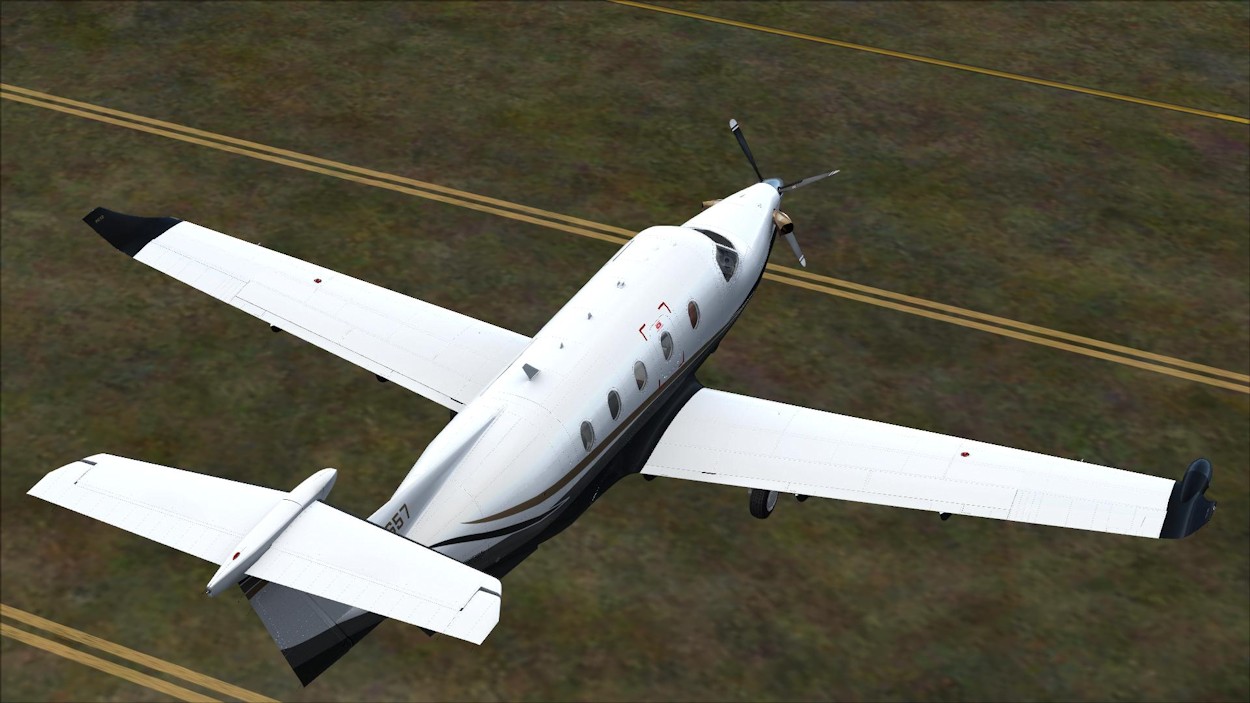
Distinctive |
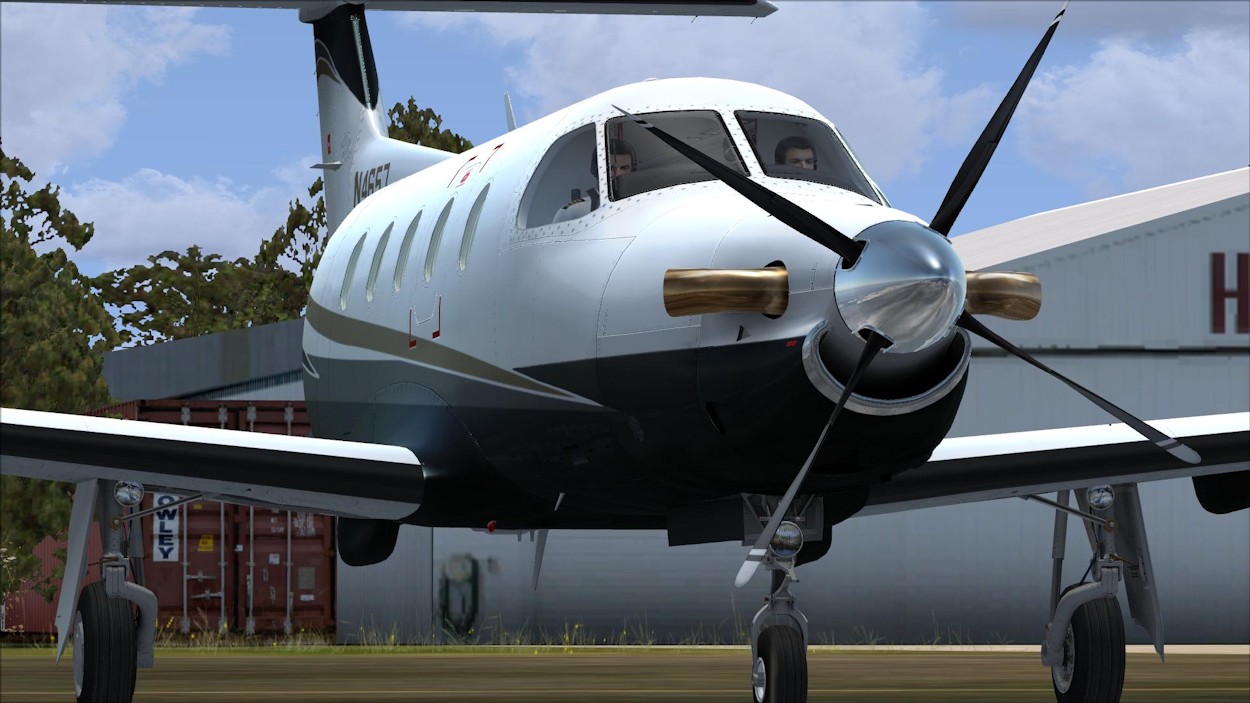
The P&W PT6A |
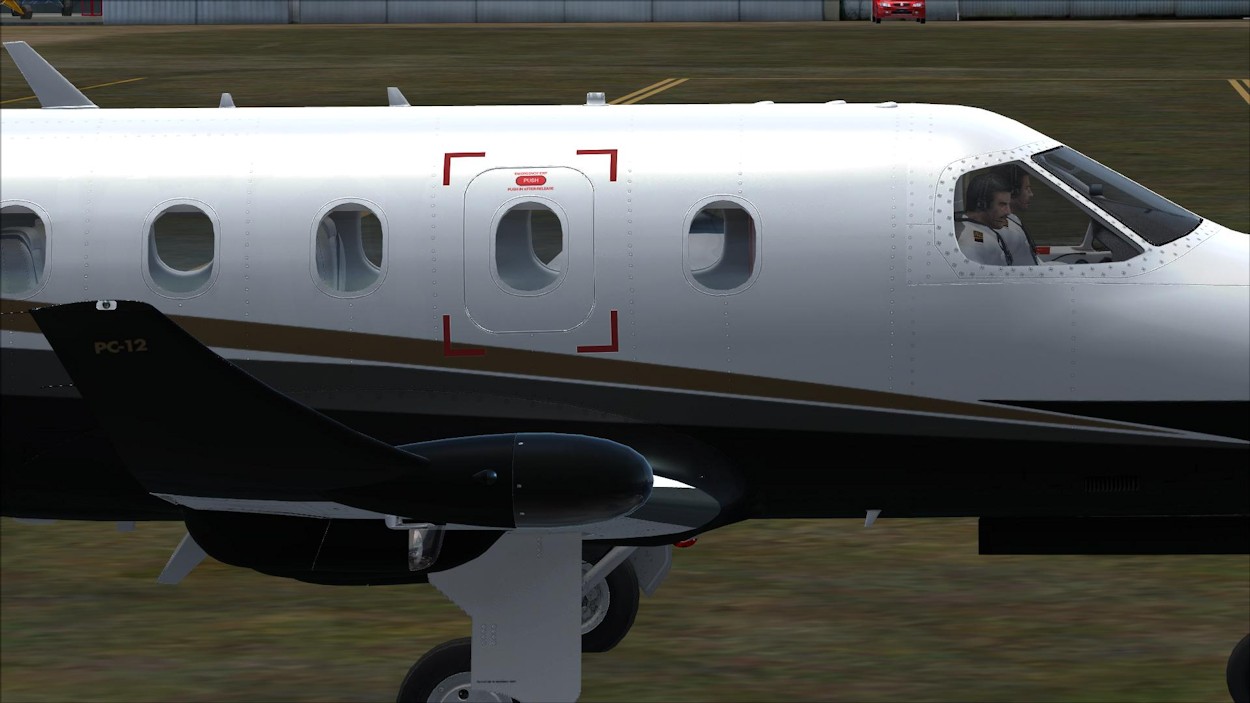
Winglet & Weather Radar |

The Cockpit |
|
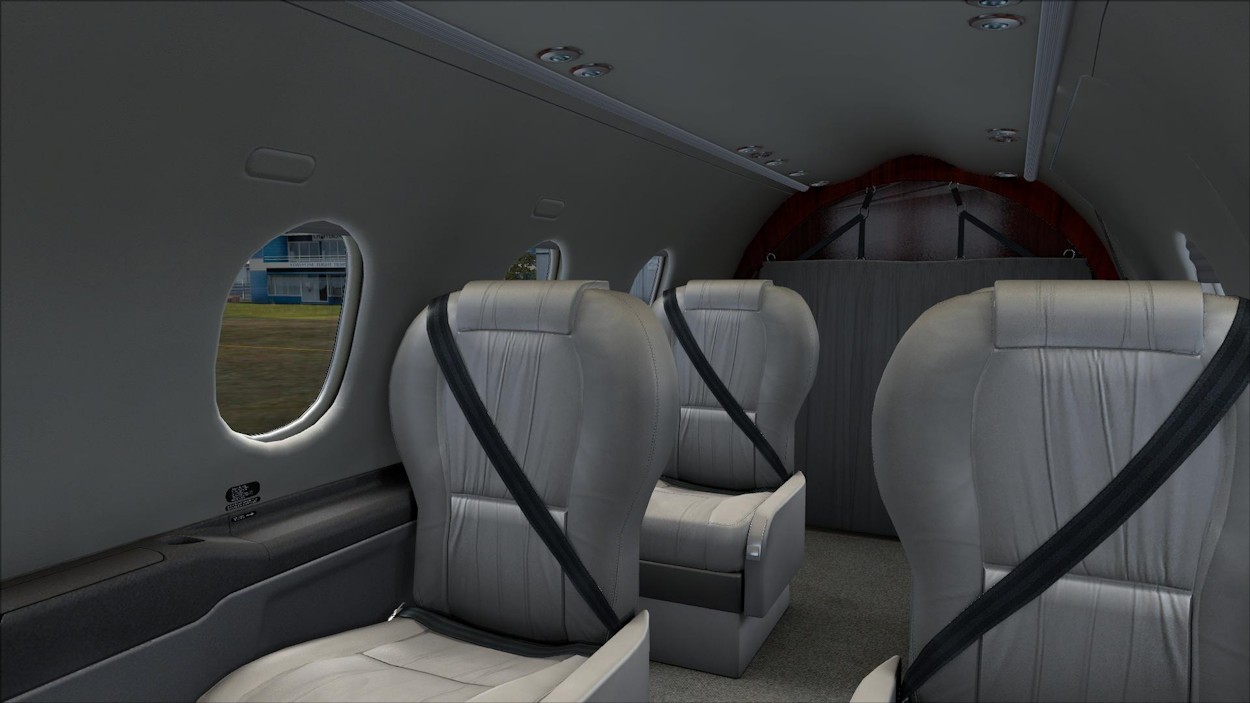
The Cabin |
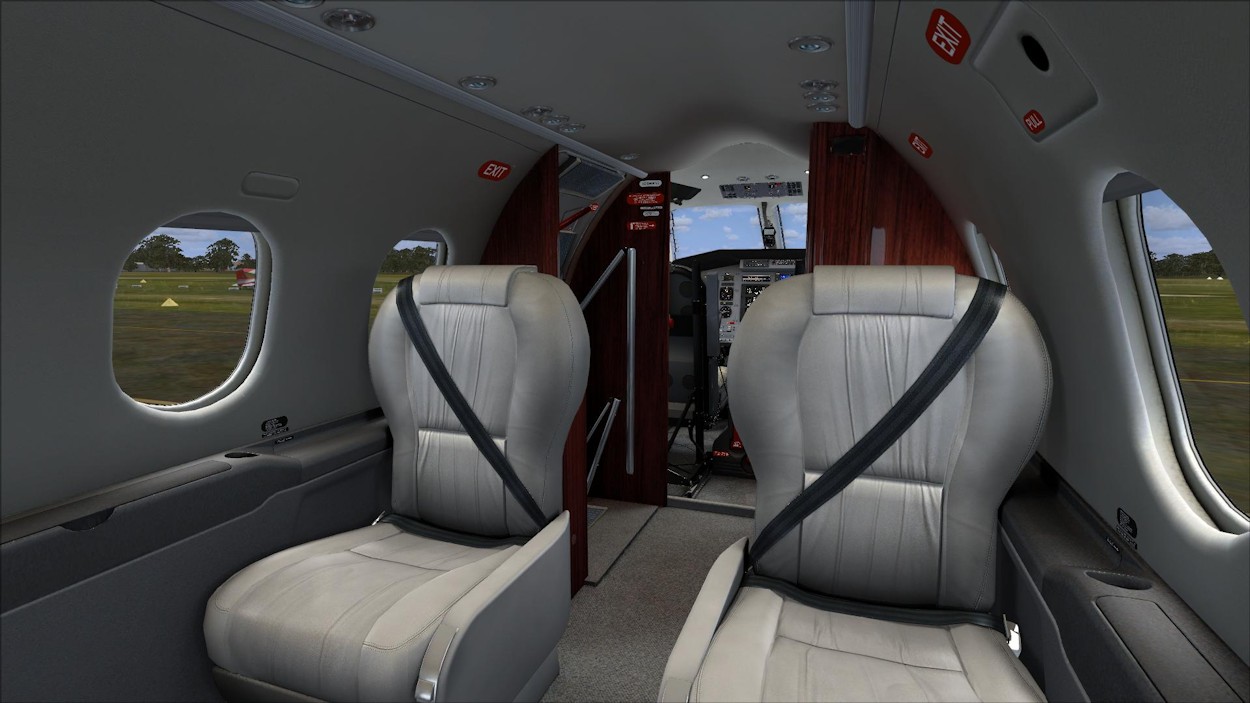
Sit Back & Enjoy Your G&T |

Instrument Panel |
|

Pilot Position |

Avidyne MFD & Switches |

Throttle Quadrant |

Overhead Panel |

HB-FCL |

D-FESV |

D-FCAH |
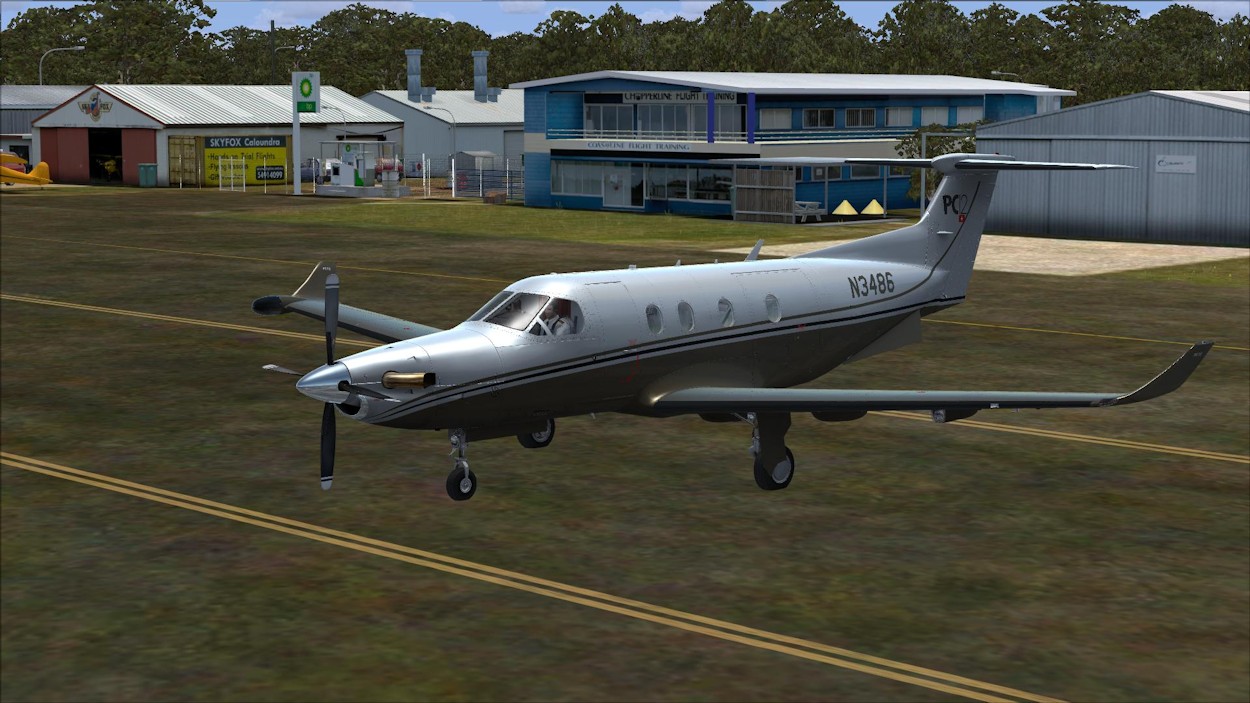
N3486 |
The animations of the primary and secondary control surfaces and other moving elements on Carenado's Pilatus PC-12 are all modelled faithfully and include:
• primary control surfaces – ailerons, elevator and rudder;
• secondary control surfaces – flaps;
• others – retractable gear, trim tabs, rolling wheels, cabin door open / close, baggage door open / close, cockpit window visors, and
cabin window shades; and
• various static ground elements.

Parked Up |

Shades Down |

Cockpit Lighting |
|

Cabin Flood Lighting |
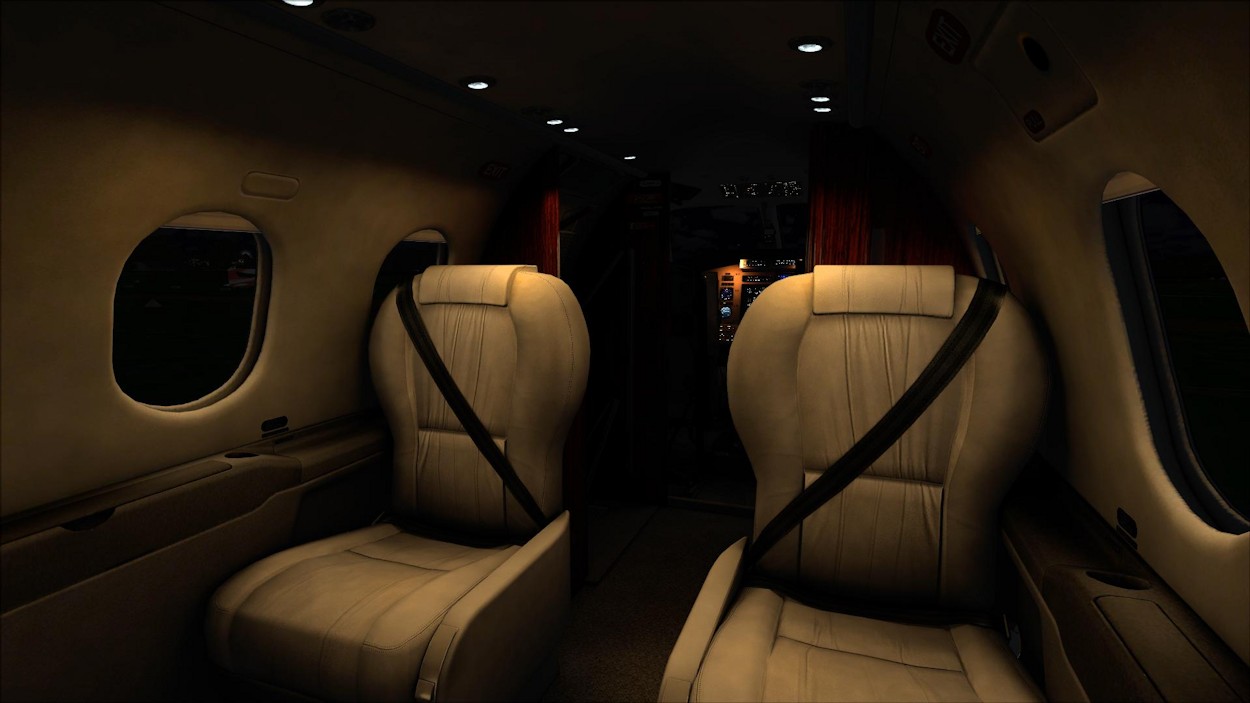
Cabin Reading Lighting |
General Characteristics and Performance Specifications
The general characteristics and performance specifications for the Pilatus PC-12 are provided in the table. This is based on data from the official Pilatus PC-12 Pilot Operating Handbook, data provided by Carenado, and general research sources. Some of this data varies between sources and also may be an approximation due to variances in data and the specific aircraft modelled by Carenado.

Flight Performance
A specific Test Flight was conducted from Avalon (YMAV) to Telfer (YTEF) to test the flight performance of Carenado's Pilatus PC-12. The flight was conducted in clear weather with a full fuel load and the aircraft at maximum take-off weight (MTOW). A cruise altitude of FL280 was adopted and the route distance was approximately 1,509 nm. The route was particularly chosen to provide a basis upon which to test the range characteristics of the PC-12. Like most aircraft of this type, adjustments must be made to fuel / pax loading to remain within the MTOW limitations.

In Flight |

Long Distance Capability |
During cruise, with an NG setting of 95%, a torque setting of 24.8 was established. This cruise setting produced an average speed of approximately 245 KTAS (155 KIAS), a fuel flow rate of approximately 310 lb/h, and an endurance consistent with the range characteristics of the aircraft. This represented a variance in speed and fuel flow performance compared to the Performance Tables provided by Carenado. The Performance Tables indicate the performance settings, as used in the Test Flight, should have produced a cruise speed of 252 KTAS (150 KIAS) and a fuel flow rate of 350 lb/h. The Test Flight confirms the modelling of the aircraft for range performance to be reasonably accurate. The detected variances in the speed and fuel flow rate do not significantly impact the range performance of the aircraft and are not considered significant.

Underbelly |

Landing Gear |
In testing the accuracy of the instruments, based on the measured Test Flight, the speed indications on the airspeed indicator, were consistent with the averages measured. Additionally, when establishing a set rate of climb on the vertical speed indicator, the respective gain in altitude on the altimeter was achieved within the measured minute, and a standard rate turn was achieved within the measured two minute period using the turn coordinator.
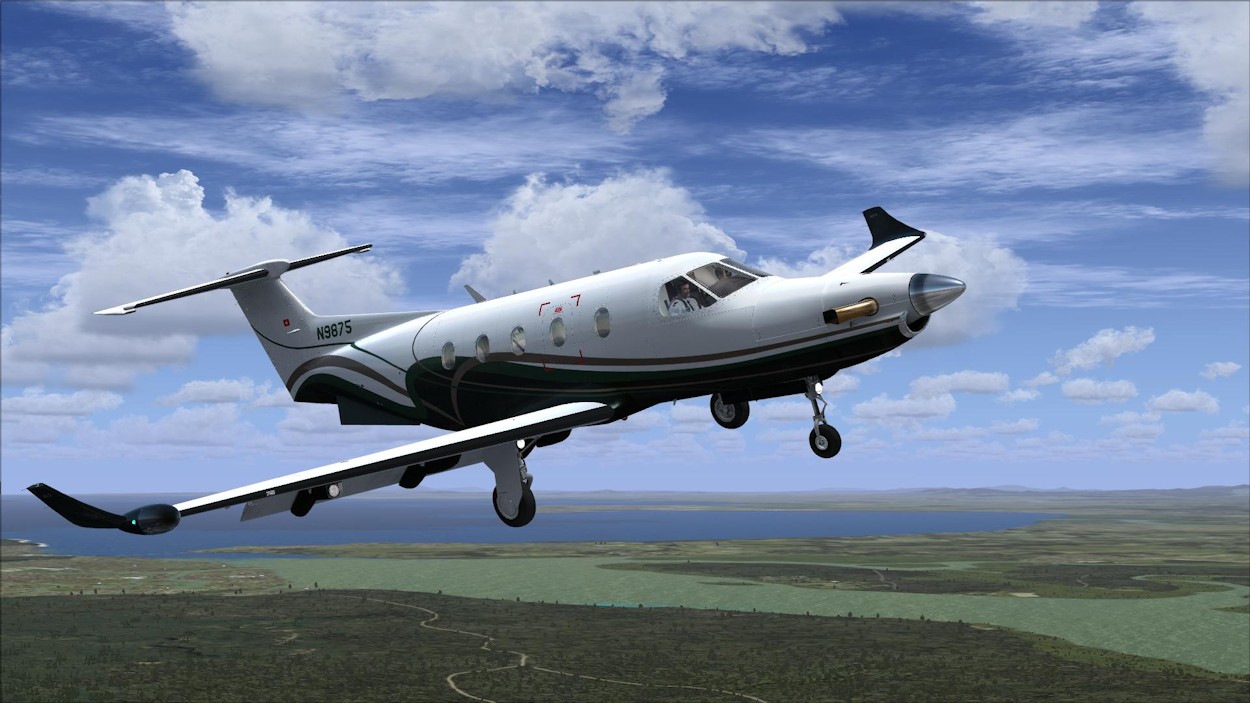
Turning for Finals |

Final Approach |
Documentation
There are eight manuals / documents provided in Adobe Acrobat format (.pdf) for the Pilatus PC-12:
• Electronic Flight Information System - this seven page manual details the operating of the EFIS avionics suite;
• Carenado Multifunction Display - this 13 page manual details the operating of the Avidyne MFD;
• Carenado GNS 530 Users Guide - this two page document details the operating of the Garmin GNS 530 GPS unit;
• Normal Procedures - this 26 page manual details the procedures for the normal operation of the aircraft;
• Emergency Procedures – this 24 page manual details the emergency procedures for the aircraft;
• Performance Tables – this three page document details the performance tables and specifications for the aircraft;
• References - this three page document details the airspeed limitations for the aircraft; and
• FSX Recommended Settings – this two page document detailed recommended FSX settings for display and realism.
An additional document provides information on the integration of the Reality XP GNS 530 GPS unit.
Value for Money
On a value for money assessment, the Carenado Pilatus PC-12 is considered excellent.
Simulator Performance
The aircraft model performed excellently within the existing settings I have in FSX. I have most of my settings set very high and there was no need to make any adjustments. FSX continued to perform smoothly and as it would with any default aircraft.
Technical Requirements
This version of the Carenado Pilatus PC-12 is for FSX / P3D only. Other specified technical requirements are as follows:
• Windows XP (with SP3 installed), Windows Vista, or Windows 7 (32 or 64bit);
• Microsoft Flight Simulator FSX with SP1 and SP2 (or Acceleration Pack) or Lockheed Martin Prepar3d Flight Simulator v1.4 or v2.0 installed; and
• Pentium V, 3GHz or similar, 2GB RAM, 512MB graphics card, and 715MB available HDD space.
Review Computer Specifications
The specifications of the computer on which the review was conducted are as follows:
• Intel i7 990X Extreme 3.46GHz;
• NVidia GTX580, 1536MB graphics;
• 12GB Kingston DDR3 2000MHz;
• Windows 7, (64bit);
• Microsoft Flight Simulator FSX Acceleration; and
• additional major add-ons include: Active Sky Next, REX Essential Plus Overdrive; Ultimate Traffic 2; Orbx FTX Global BASE;
Orbx FTX Global VECTOR; Orbx FTX Global openLC EU; Orbx FTX region series; and Orbx FTX airport series.
Conclusion
Carenado have done an excellent job with the Pilatus PC-12 and it is a fantastic complement to the other single engine turboprops in their repertoire Displaying the hallmark Carenado traits of detail and accuracy, the PC-12 displays an excellent balance of quality and detail at an excellent price. With exemplary cruise speed, range / payload characteristics, and STOL capabilities, the PC-12 is a brilliant aircraft and one you will enjoy flying.
Verdict
Displaying the usual high quality and attention to detail, the Pilatus PC-12 is another fine product from Carenado which represents excellent overall value for money.
Pros:
Quality and attention to detail.
Realistic modelling and performance.
Comprehensive documentation.
Excellent value for money.
Cons:
AV 1 and AV 2 switch operation.
ADF Receiver 'click spots' difficult to locate.
Lighting switch controls.
| Scores: |
 | |
| ● External Model: | 10/10 | |
| ● Internal Model: | 8.5/10 | |
| ● Sounds: | 10/10 | |
| ● Flight Characteristics (does it fly by the numbers): | 9.5/10 | |
| ● Flight Dynamics (does it feel like what it looks like): | 9.5/10 | |
| ● Documentation: | 10/10 | |
| ● Value for Money: | 9.5/10 |
The Carenado Pilatus PC-12 is awarded an overall Mutley’s Hangar score of 9.6/10, with an "Outstanding" and a Mutley's Hangar Gold Award. |
